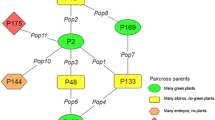Abstract
A quantitative genetic analysis was conducted to determine the inheritance of androgenetic response in hexaploid triticale. One highly-responsive genotype (Do 1 triticale) and three low-responding advanced CIMMYT lines (Rhino, Juanillo 97 and Ira Drira) were used as parents to produce a complete set of reciprocal F1, F2 and backcross generations. Estimates for genetic effects were determined using a generation-mean analysis following the method of Mather and Jinks. Both embryo induction and plant regeneration potential fitted well with the simple three-parameter additive-dominance (AD) model indicating the absence of any significant epistatic effects. Highly significant additive effects were detected for embryo induction, suggesting that breeding and selection can be effective in improving the induction response of triticale. The high [d]/[h] ratio indicates dominance of the alleles causing high embryo induction. The production of regenerant plants from embryos appeared to be a more complex trait because of its high sensitivity to environmental factors.
Similar content being viewed by others
References
Agache S, Bachelier B, de Buyser J, Henry Y, Snape, J (1989) Genetic analysis of anther-culture response in wheat using aneuploid, chromosome substitution and translocation lines. Theor Appl Genet 77:7–11
Becraft PW, Taylor GA (1992) Genetic variation for anther callus inducibility in crosses of highly culturable winter wheats. Plant Breed 108:19–25
Bullock WP, Baenziger PS, Schaeffer GW, Petolino PJ (1982) Anther-culture of wheat (Triticum aestivum L) F1's and their reciprocal crosses. Theor Appl Genet 62:155–159
Cavalli LL (1952) An analysis of linkage in quantitative inheritance. In: Reeve ECR, Waddington CH (eds) Quantitative inheritance. HMSO, London, pp 135–144
Charmet G, Bernard S (1984) Diallel analysis of androgenetic plant production in hexaploid triticale (x Triticosecale Wittmack). Theor Appl Genet 69:55–61
Chien YC, Kao, KN (1983) Effects of osmolality, cytokinin and organic acids on pollen callus formation in triticale anthers. Can J Bot 61:639–641
Deaton WR, Metz SG, Armstrong TA, Mascia PN (1987) Genetic analysis of the anther-culture response of three spring wheat crosses. Theor Appl Genet 24:334–338
Foroughi-Wehr B, Friedt W, Wenzel G (1982) On the genetic improvement of androgenetic haploid formation in Hordeum vulgare L. Theor Appl Genet 62:233–239
Genstat V Reference Manual (1987) Oxford University Press, UK
Jinks JL, Jones RM (1958) Estimation of the components of heterosis. Genetics 42:223–234
Lazar MD, Baenziger PS, Schaeffer GW (1984) Combining abilities and heritability of callus formation and plantlet regeneration in wheat (Triticum aestivum L.) anther-cultures. Theor Appl Genet 68:131–134
Luckett DJ, Venkatanagappa S, Darvey NL, Smithard RA (1991) Anther-culture of Australian wheat germplasm using modified C17 medium and membrane rafts. Aust J Plant Physiol 18:352–367
Lukjanjuk SF, Ignatova SA (1986) Triticale: production of haploid and homozygous plants. In: Bajaj YPS (ed) Biotechonology in agriculture and forestry. Vol 2, Crops. Springer, Berlin Heidelberg New York Tokyo, pp 530–543
Mather K (1949) Biometrical Genetics 1st edn. Methuen, London
Mather K, Jinks JL (1982) Biometrical genetics: the study of continuous variation. Chapman and Hall, London New York
Miah AAA, Earle ED, Khush GS (1985) Inheritance of callus formation ability in anther-culture of rice, Oryza sativa L. Theor Appl Genet 70:113–116
Murashige T, Skoog S (1962) A revised medium for rapid growth and bioassays with tobacco tissue cultures. Physiol Plant 15: 473–497
Petolino JF, Thompson SA (1987) Genetic analysis of anther-culture response in maize. Theor Appl Genet 74:284–286
Schumann G (1990) In-vitro production of haploids in triticale. In: Bajaj YPS (ed) Biotechnology in agriculture and forestry. Vol 13, Wheat. Springer, Berlin Heidelberg New Yorck Tokyo pp 382–402
Sozinov A, Lukjanjuk S, Ignatova S (1981) Anther cultivation and induction of haploid plants in triticale. Z. Pflanzenzucht 86:272–285
Wang X, Hu H (1984) The effects of potato II medium for triticale anther-culture. Plant Sci Lett 36:237–239
Warner JN (1952) A method for estimating heritability. Agron J 44: 427–430
Wenzel GF, Hoffmann F, Thomas E (1977) Increased induction and chromosome doubling of androgenetic haploid rye. Theor Appl Genet 51:81–86
Author information
Authors and Affiliations
Additional information
Communicated by G. Wenzel
Rights and permissions
About this article
Cite this article
Balatero, C.H., Darvey, N.L. & Luckett, D.J. Genetic analysis of anther-culture response in 6x triticale. Theoret. Appl. Genetics 90, 279–284 (1995). https://doi.org/10.1007/BF00222215
Received:
Accepted:
Issue Date:
DOI: https://doi.org/10.1007/BF00222215




